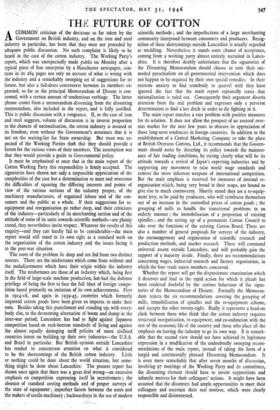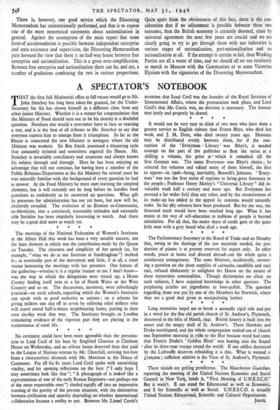TH E FUTURE
OF COTTON
ACOMMON criticism of the decisions so far taken by the Government on British industry, and on the iron and steel industry in particular, has been that they were not preceded by adequate public discussion. No such complaint is likely to be heard in the case of the cotton industry. The Working Party's report, which was unexpectedly made public on Monday after a typical piece of free enterprise by a Manchester newspaper, con- tains in its 284 pages not only an account of what is wrong with the industry and a remarkably sweeping set of suggestions for its future, but also a full-dress controversy between its members ex- pressed, so far as the principal Memorandum of Dissent is con- cerned, with a certain amount of tendentious verbiage. The latter phrase comes from a memorandum dissenting from the dissenting memorandum, also included in the report, and is fully justified. This is public discussion with a vengeance. If, as the case of iron and steel suggests, volume of discussion is in inverse proportion to the chances of nationalisation, the cotton industry is assured ot its freedom, even without the Government's assurance that it is not on the waiting-list for State ownership. But more was ex- pected of the Working Parties that' that they should provide a forum for the various views of their members. The assumption was that they would provide a guide to Governmental policy.
It must be emphasised at once that in the main report of the Cotton Working Party this responsibility is firmly accepted. The signatories have shown not only a responsible appreciation of tho complexities of the case but a determination to meet and overcome the difficulties of squaring the differing interests and points of view of the various sections of the industry proper, of the machinery manufacturers, of organised labour 'and of the con- sumers and the public as a whole. If their suggestions for re- equipment and reorganisation go rather deep, and their criticisms of the industry—particularly of its merchanting section and of the attitude of some of its units towards scientific methods—are plainly stated, they nevertheless invite respect. ,Whatever the results of this enquiry—and they can hardly fail to be considerable—the main report would still stand in its own right as a standard work on the organisation of the cotton industry and the issues facing it in the post-war situation.
The roots of the problem lie deep and are fed from two distinct sources. There are the misfortunes which come from without and the maladjustments which have their origin within the industry itself. The misfortunes are those of an industry which, being first in the field of large-scale machine production, has had the dubious privilege of being the first to face the full blast of foreign compe- tition based primarily on imitation of its own achievements. First in 1914-18, and again in 1939-45, countries which formerly imported cotton goods have been given an impetus to make their own. Besides taking this punishment and standing up, with every- body else, to the devastating alternation of boom and slump in the inter-war period, Lancashire has had to fight against Japanese competition based on rock-bottom standards of living and against the almost equally damaging tariff policies of more civilised countries intent on building up their own industries—the U.S.A. and Brazil in particular. But British opinion outside Lancashire has tended to concentrate attention on what it considered to be the shortcomings of the British cotton industry. Little or nothing could be done about the world situation, but some- thing might be done about Lancashire. The present report has shown once again that there was a great deal wrong—an excessive emphasis on competition expressing itself In secretiveness ; the absence of standard costing methods and of proper surveys of the state of equipment ; imperfect liaison between the users and the makers of textile machinery ; backwardness in the use of modern scientific methods ; and the imperfections of a large merchanting community interposed between consumers and producers. Recog- nition of these shortcomings outside Lancashire is usually regarded as meddling. Nevertheless it stands some chance of acceptance, coming from a working party almost entirely recruited in Lanca- shire. It is therefore doubly unfortunate that the signatories of the Dissenting Memorandum should choose to vent their out- moded parochialism on all governmental intervention which does not happen to be required by their own special remedies. In their extreme anxiety to find somebody to quarrel with they have ignored the fact that the main report repeatedly states that nationalisation is ruled out. Consequently their argument diverts attention from the real problem and expresses only a perverse determination to find a last ditch in order to die fighting in it.
The main report matches a vast problem with positive measures for its solution. It does not allow the prospect of an assured over- seas market for the next few years to obscure its appreciation of those long-term tendencies in foreign countries. In addition to the establishment of a Central Marketing Company to take the place of British Overseas Cottons, Ltd., it recommends that the Govern- ment should assist by directing its policy towards the mainten- ance of fair trading conditions, by stating clearly what will be its attitude towards a revival of Japan's exporting industries and by supporting any movement to raise world wage standards and remove the more inhuman weapons of international competition. But the main emphasis is reserved for measures of internal re- organisation which, being very broad in their scope, are bound to give rise to much controversy. Shortly stated they are a re-equip- ment levy, to be paid by producers, who will reimburse themselves out of an increase in the controlled prices of cotton goods ; the grouping of mills to handle the transitional problems in an orderly manner; the immobilisation of a proportion of existing spindles ; and the setting up of a permanent Cotton Council to take over the functions of the existing Cotton Board. There are also a number of general proposals for surveys of the industry, the encouragement and organisation of scientific research and production methods, and market research These will command universal assent outside Lancashire, and will probably gain the support of a majority inside. Finally, there are recommendations concerning wages, industrial research and factory organisation, in which the four trade union members concurred.
Whether the report will get the dispassionate examination which it deserves and lead to the rapid action for which it pleads has been rendered doubtful by the curious behaviour of the signa- tories of the Memorandum of Dissent. Formally the Memoran- dum rejects the six recommendations covering the grouping of mills, immobilisation of spindles and the re-equipment scheme, and accepts the other twenty-eight. Really it represents a head-on clash between those who think that the cotton industry requires structural reorganisation, re-equipment, and co-ordination with the rest of the economic life of the country and those who place all the emphasis on leaving the industry to go its own way. It is remark- able that the second view should not have achieved its legitimate expression in a modification of the undoubtedly sweeping recom- mendations of the main report, instead of taking the form of a turgid and sentimentally phrased Dissenting Memorandum. It is even more remarkable that after seven months of discussion, involving 97 meetings of the Working Party and its committees, the dissenting element should have to invent suppositions and infantile motives for their colleagues' actions. It might have been assumed that the dissenters had ample opportunities to meet their colleagues and ascertain their real motives, which were clearly responsible and disinterested. There is, however, one good service which the Dissenting Memorandum has unintentionally performed, and that is to expose one of the more nonsensical statements about nationalisation in general. Against the assumption of the main report that some form of accommodation is possible between independent enterprise and state assistance and supervision, the Dissenting Memorandum puts forward the view that there is no half-way house between free enterprise and nationalisation. This is a gross over-simplification. Between free enterprise and nationalisation there can be, and are, a number of gradations combining the two in various proportions. Quite apart from the obviousness of this fact, there is the con- sideration that if no adjustment is possible between these two extremes, then the British economy is certainly doomed, since by universal agreement the next few years are crucial and we are clearly going to try to get through them with our industries in various stages of nationalisation, part-nationalisation and no nationalisation at all. If the attempt is certain to fail, then Working Parties are all a waste of time, and we should all set out resolutely to march to Moscow with the Communists. or to some Victorian Elysium with the signatories of the Dissenting Memorandum.































 Previous page
Previous page